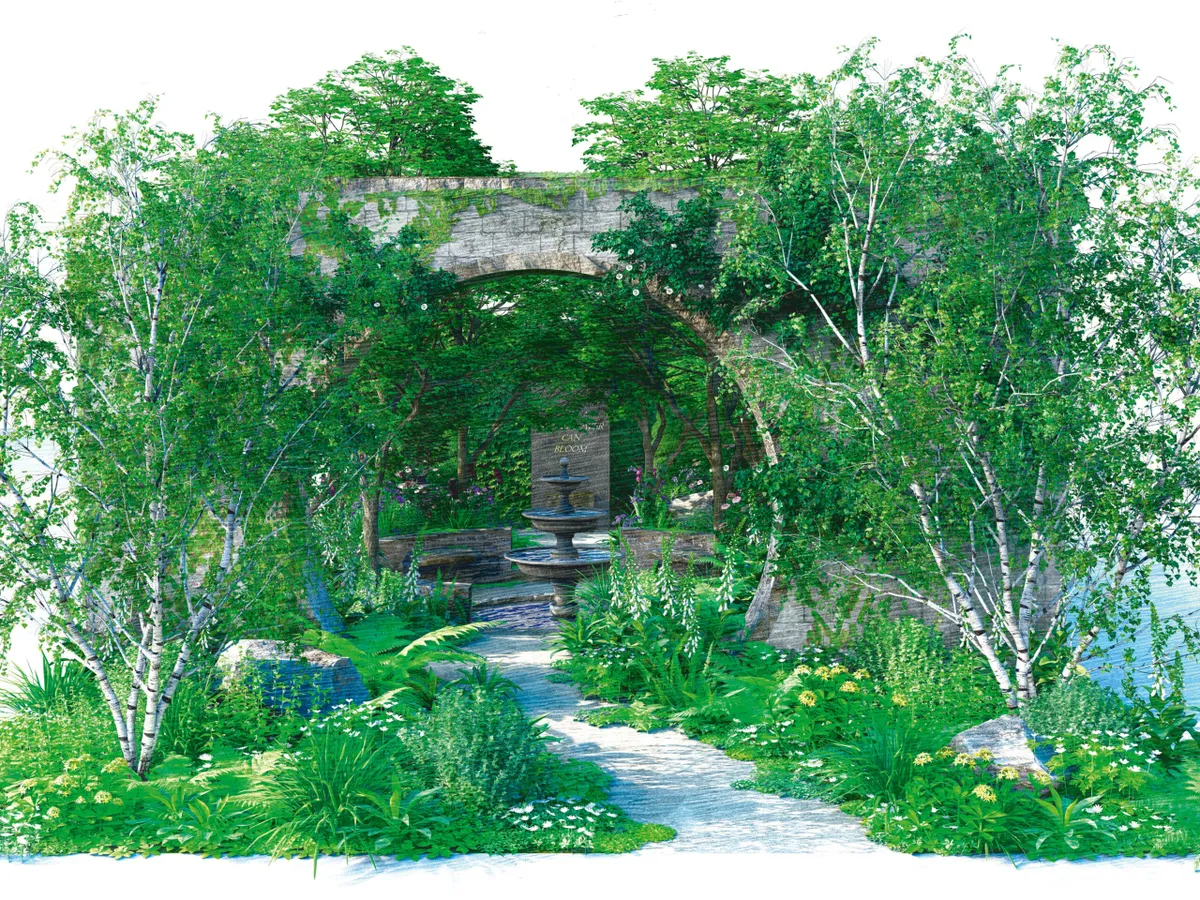It’s difficult to predict what the big trends will be at the Chelsea Flower Show each year, but we have trawled the garden designs and spoken to designers and growers to draw out the themes we think will take the spotlight at the 2024 show.
Health and community
The general themes of health and inclusion are once again to the fore, with several projects sponsored via the Project Giving Back scheme based on the management of, or recovery from, conditions such as muscular dystrophy, cancer and stroke, and featuring biophilic and therapeutic design elements. There are gardens concerned with HIV and skin diseases, as well as those designed for people who are grieving, and those with learning disabilities and/or autism.
You may also like:
- Sign up to our Chelsea Flower Show newsletter
- Everything you need to know about designing a Chelsea garden
- Tickets, dates and information for Chelsea Flower Show
More of the show gardens than ever are accessible, such as the Panathlon Joy Garden, which is the first wheelchair-accessible All About Plants garden to feature at Chelsea. Miria Harris’s and Ann-Marie Powell’s gardens also feature sloping paths rather than steps, with spaces and surfaces within considered in terms of ease of movement for wheelchair users.

Many designs are based on the idea of a communal or public garden space where people can come together, including Robert Myers’ St James’s Piccadilly Garden, which will also feature a sculptural timber counselling cabin.
Beautiful boundaries
With sustainability becoming a central focus for this year’s show, and so many designers trying to go cement and concrete free, it’s not surprising that many of the designs highlight interesting materials, especially for boundaries and dividing features. Natural materials abound, from the simple chestnut posts and hazel rods edging Tom Stuart-Smith’s National Garden Scheme (NGS) woodland garden to the bold, enveloping willow dividers in The Freedom from Torture Garden.

A collaboration between John Warland and willow artist Tom Hare, they are intended to create informal spaces for therapy or relaxing in, helping the garden feel like a ‘horticultural hug’. The rear of Dan Bristow’s Size of Wales garden boasts an 8m-long, compostable ‘fungus fence’ – highlighting the importance of fungi in the health of forests – made from woodland thinnings and inoculated with oyster and lion’s mane mushrooms. Materials usually used in the sustainable building trade will also feature. The Stroke Association’s garden has a wall of hempcrete blocks finished with a lime render, while the National Autistic Society Garden features expanded cork walls as dividers.
Recycled materials play a key role too

Ula Maria’s woodland garden for Muscular Dystrophy UK features a bungaroosh wall, traditionally a cheap way to create a wall using leftover materials on a building site. Ula’s beautiful example echoes the reclaimed materials used around the garden. The boundary of Matthew Childs’ Terrence Higgins Trust Garden is recycled timber, and in the RHS Chelsea Repurposed Garden by Darryl Moore, a ‘celebration of creative recycling’, nearly everything has already appeared in a Chelsea garden before.
Water, water everywhere
Water is everywhere at Chelsea this year. It’s as if designers knew that winter and spring would be among the wettest on record, because many are looking at ways to make the most of rain and manage an abundance of it. The WaterAid and Flood Re gardens are entirely built around these ideas, but others, such as The NGS Garden and The Water Saving Garden by Sam Proctor, also feature rainwater-harvesting systems. The gentle sound of running water will be all around from the multitude of watercourses on show, from Ula Maria’s soft-edged rill to slow run-off rainwater, to The Freedom from Torture Garden’s sinuous channel.
We predict more of a noisy splashing sound from the RHS No Adults Allowed Garden by Harry Holding, where a natural den has been sunk into a wetland pool with an invitation for kids to let loose in their wellies. For the adults, it’s more of a dunk on offer, in the cold plunge pool that is the centrepiece of The Ecotherapy Garden by Tom Bannister. There are also lots of wildlife ponds, and several cascades, with Kazuyuki Ishihara’s tumbling waterfall and a daring pergola-fed feature in the Killik & Co garden.
- Chelsea Flower Show Main Show Gardens 2024: the full list
- Chelsea Flower Show 2024: tickets, information, dates and what's on
- 10 essentials for visiting the RHS Chelsea Flower Show
The prize for the most intriguing aquascape goes to Matthew Childs for his flooded quarry garden, the water level of which will rise and fall during the show.

But we predict the most Instagrammed water feature at the show will probably be the Regency-inspired fountain on the Bridgerton garden designed by Holly Johnston and sponsored by Netflix, with many visitors wishing to have their own Featherington fantasy moment from the hit show.

Edible landscapes
When it comes to planting, because of the time of year, late-spring plants abound in woodland-style schemes with lots of multi-stemmed trees. That aside, even the nurseries growing plants to order for the show are finding it difficult to identify a common thread in what they’ve been asked to produce, apart from a heavier focus on resilient and native plants – meaning plenty of diversity in the planting schemes across the show.

One trend we have noticed is that many designers are weaving edible plants into their designs for aesthetic as well as edible value, a practice known as foodscaping. These ‘edimentals’ (edible ornamentals) feature in several gardens, including The Bowel Research UK Microbiome Garden, where Bistorta officinalis and camassias are being championed as edibles. The Pulp Friction – Growing Skills Garden features medlars, filberts, a pretty yellow cultivar of alpine strawberries and an edible hedge made of runner beans with red-and-white flowers. In The Freedom from Torture Garden, edible plants such as chickpeas, nigella and cardoon are part of the planting scheme. The Planet Good Earth Garden, which has been designed as a food forest, features hydroponic grow towers planted with rainbow chard and kale alongside hanging mushroom sacks.
Designer pairs
Seven of the show gardens this year have been designed by two people. Some of the pairs have known each other for a while. Will Dutch and Tin-Tin Azure-Marxen (Pulp Friction – Growing Skills Garden) work together in their day jobs, having met at Writtle University College. Sid Hill and Chris Hull (Bowel Research UK Garden) met as teenagers and studied together at Duchy College before eventually setting up their own landscape businesses.
Two gardens are collaborations between garden designers and architects. Tom Massey and architect Je Ahn (WaterAid Garden) first worked together for the London Design Festival in 2020. Designer Sophie Parmenter initially contacted architect Dido Milne about using expanded cork for the National Autistic Society Garden; they have ended up working on the garden together.
On the Flood Resilient garden, writer and garden consultant Naomi Slade teamed up with Dr Ed Barsley, a specialist in environmental design and flood resilience.
The Freedom from Torture Garden is the first pairing of six-time RHS Gold medal-winning conceptual artist John Warland and award-winning garden designer Emma O’Connell.
Collaborating means taking advantage of complementary skillsets and spreading a heavy workload. “It’s having someone to run things past, to talk through a decision or an issue that has arisen,” says Will Dutch. “The second pair of eyes helps with the confidence in delivering something great.” Dido Milne points out: “You go on a journey you might not expect at the beginning.” Naomi Slade adds: “You learn about things that are out of your normal sphere – and you gain a new perspective on things.”

